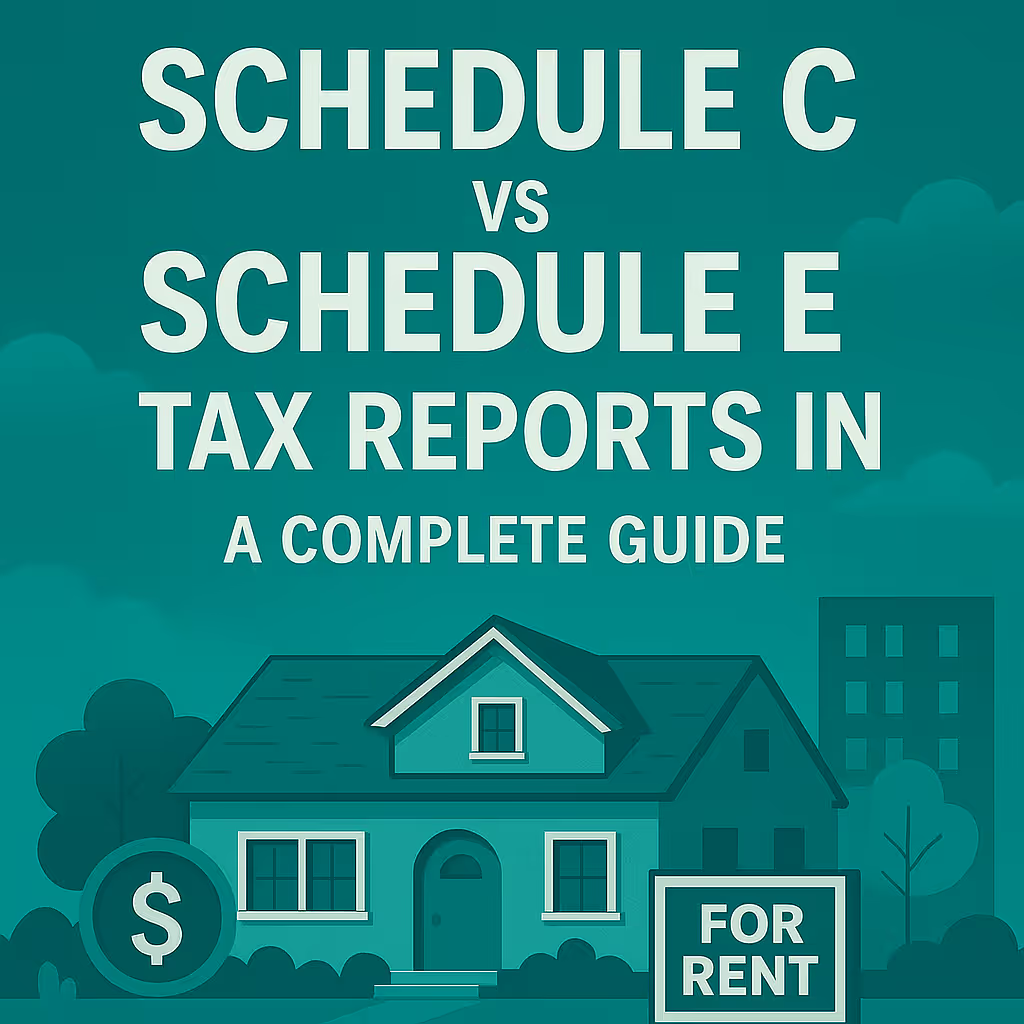
When managing rental properties, one of the most critical decisions you’ll face during tax season is whether to report your rental income using Schedule C or Schedule E. With Rentastic’s automated tax reporting features that generate P&L statements in seconds, understanding these tax forms becomes even more important for maximizing your deductions and ensuring compliance.
Schedule E is used to report income and expenses related to real estate rentals for most landlords. This form is designed for what the IRS considers **passive income** activities.
- Income reported on Schedule E is not subject to self-employment tax
- Deductions declared on Schedule E can only be deducted against passive income
- You are subject to passive activity rules which limit the losses you are allowed to deduct
- If your losses exceed your passive income or the $25,000 passive loss limitation, the additional losses are carried forward into future tax years
Schedule C is used when you provide substantial services that are primarily for your tenant’s convenience. This form treats your rental activity as an active business.
- Income reported on Schedule C is subject to self-employment tax
- You are allowed to deduct any business expenses that are ordinary and necessary in running your operations
- Because you materially engage in your business, you are not subject to passive activity rules and your losses are not capped
Schedule E is appropriate for most rental property owners, including:**
- Property owners who provide basic services (heat, light, water, trash removal)
- Investors with long-term rental properties
- Those reporting passive rental income where the IRS limits passive losses to $25,000 if AGI is below $100k, phasing out for AGI’s up to $150,000
If you engage in vacation or short-term rentals with minimal participation and no substantial services, you report it on Schedule E.
Most Rentastic users will find Schedule E to be the appropriate choice, especially when the platform’s automated features help track:
- Rental income from multiple properties
- Standard rental expenses (maintenance, insurance, property management)
- Depreciation calculations
- Basic operational costs
Schedule C is appropriate for rental property owners who:**
Offering substantial services categorizes your rental activity as a business, reportable on Schedule C. These services might include:
- Daily housekeeping
- Meal service
- Concierge services
- Regular linen changes
For investors with multiple rental properties, Schedule C might be the right choice if you qualify for real estate professional status. To qualify as a real estate professional, you must meet both requirements: more than half of your personal services are performed in real property trades or businesses where you materially participate, and you perform more than 750 hours of services during the tax year.
If you rent out your property on Airbnb, VRBO, or similar platforms and are actively involved in managing the rental and providing services to guests, this income should generally be reported on Schedule C.
The choice between schedules significantly impacts your tax liability:
Schedule C: You’ll pay self-employment tax (15.3%) on net profits
Schedule E: No self-employment tax on rental income
The amount of passive losses allowed on Schedule E depends on your adjusted gross income (AGI), while Schedule C losses aren’t limited in the same way.
Schedule C: Broader range of business deductions available
Schedule E: Deductions limited to rental-related expenses and subject to passive activity loss rules
Rentastic handles millions of dollars in real estate, giving you reliable info right at your fingertips, with automated bank account connections that pull in income and spending data.
Rentastic’s savvy reports whip up Profit and Loss (P&L) statements faster than you can say “tax time stress,” making tax preparation much more manageable.
Whether you choose Schedule C or Schedule E, Rentastic’s platform allows you to:
- Track income and expenses across multiple properties
- Categorize transactions automatically
- Generate property-specific financial reports
- Maintain digital receipt storage
1. **Level of Service Provided**: The level of service provided determines your classification - substantial services mean Schedule C, while minimal participation means Schedule E
1. **Time Investment**: Your material participation is determined by IRS tests, including working 500+ hours per year or doing substantially all the work
1. **Loss Scenarios**: Consider whether you expect losses and how passive activity loss limitations might affect you
1. **Professional Status**: Evaluate whether you qualify for real estate professional status
Rentastic’s comprehensive tracking can help you determine the appropriate schedule by providing:
- Detailed time tracking for services provided
- Clear separation of income and expenses by property type
- Historical data to establish patterns of material participation
With Rentastic’s receipt scanning feature, you can snap a picture, apply it to a transaction, and you’re done - no more shoebox storage.
Use Rentastic’s reporting features to regularly review your:
- Service levels provided to tenants
- Time spent on rental activities
- Income vs. expense patterns
Because determining whether you need to file Schedule C vs Schedule E depends on a variety of factors including your material participation and rental duration, it’s always recommended that you consult with a licensed tax professional.
The choice between Schedule C and Schedule E significantly impacts your tax liability and available deductions. With Rentastic’s automated reporting features that turn tax preparation from days to seconds, you can focus on making the right strategic decision rather than getting bogged down in paperwork.
Most traditional rental property owners will find Schedule E appropriate for their needs, while those providing substantial services or qualifying as real estate professionals should consider Schedule C. Regardless of which schedule you choose, Rentastic’s comprehensive tracking and reporting features ensure you have the detailed records necessary for accurate tax filing and maximum deduction opportunities.
Remember to consult with a qualified tax professional to determine the best approach for your specific situation, and let Rentastic handle the heavy lifting of record keeping and report generation.
RECENT POSTS
Comments